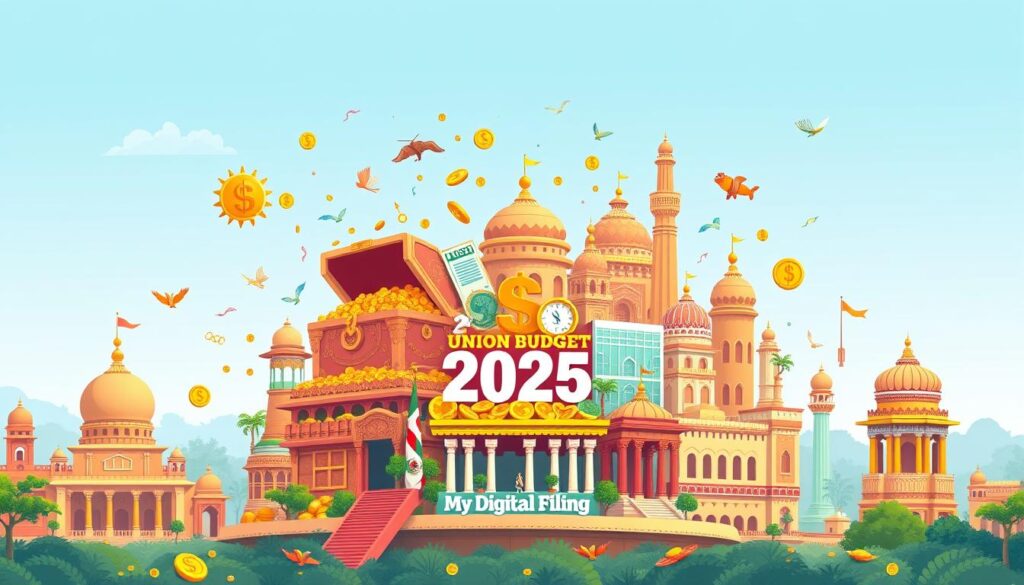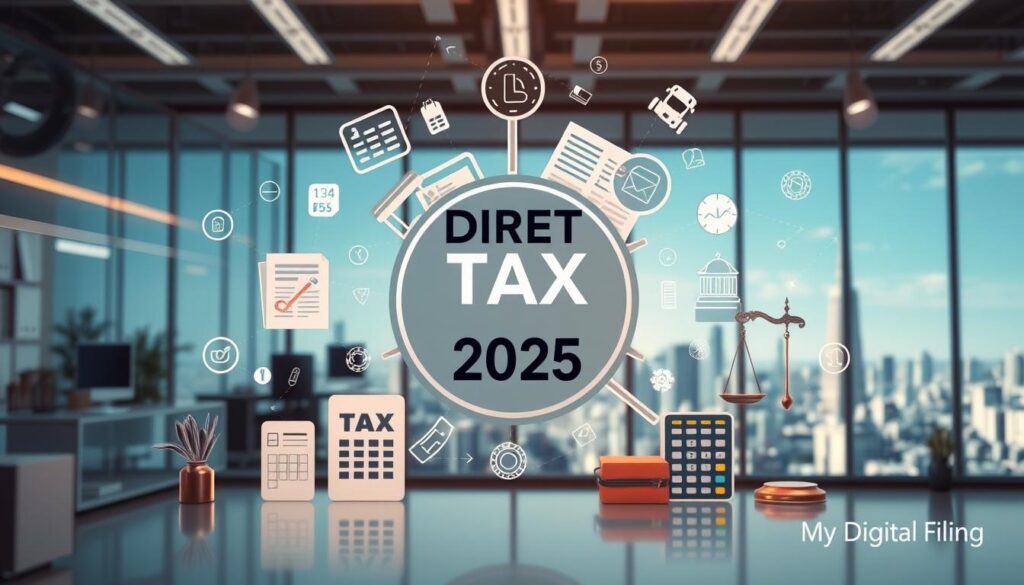Did you know only about 1% of India’s population pays income tax? The Direct Tax Code 2025 aims to increase this number to 7.5%. This new tax code will replace the Income Tax Act of 1961, bringing reforms and modernization to India’s tax system.
Finance Minister Nirmala Sitharaman introduced the Direct Tax Code 2025. She aimed to simplify laws, reduce litigation, and encourage better compliance. The code has been in development for over a decade, with the first draft in 2009 and a presentation in 2010, but faced several delays.
The Direct Tax Code 2025 aims to simplify and make taxation more transparent. It introduces changes like simplified residential status and unified tax rates for companies. It also reduces deductions and exemptions, and introduces TDS and TCS on most income.
The new code will be implemented in April 2025 for the financial year 2025-26. It’s important to note that the Direct Tax Code 2025 is not yet implemented. To learn more about the upcoming changes and their impact, check out this informative article on the upcoming Direct Tax Code 2025.
Key Takeaways
- The Direct Tax Code 2025 will replace the Income Tax Act of 1961, bringing much-needed reforms and modernization to India’s tax system.
- The new tax code aims to increase the number of income taxpayers from 1% to 7.5% of the population.
- Key changes include simplified residential status, removal of assessment year and previous year concepts, changes in capital gains taxation, new definitions for income categories, and unified tax rates for companies.
- The Direct Tax Code 2025 reduces deductions and exemptions, introduces TDS and TCS on most income, and simplifies the structure.
- The new code will be implemented in April 2025 for the financial year 2025-26 and should not be confused with changes introduced in the Income Tax Act through the Budget 2024.
Understanding the Direct Tax Code 2025: Key Changes and Insights
India is set to change its tax system with the Direct Tax Code 2025. It aims to make taxes simpler, reduce legal fights, and encourage people to follow the rules. The old Income Tax Act of 1961 is too complex, with many rules and exceptions. The new code, direct tax code 2025, is expected to make taxes clearer and easier to follow.
Why the Direct Tax Code 2025 Was Introduced
The main reason for the direct tax code 2025 is to fix the old Income Tax Act’s problems. The Act has too many old rules and is hard to follow. The government wants a simpler tax system, leading to the new code.
Goals of the Direct Tax Code 2025
The Direct Tax Code 2025 has several main goals. It aims to:
- Get more people to pay taxes, from 1% to 7.5% of the population
- Make tax rules easier to understand
- Lessen legal disputes by clearing up tax laws
- Make it easier for people to follow tax rules
These goals are to make the tax system fairer and more efficient. The importance of the direct tax code 2025 is in its ability to simplify taxes, ease the tax burden, and attract more businesses and investments to India.
As the direct tax code 2025 is set to start, it’s important to know about its changes and advantages. Understanding why and what it aims to do will help you make the most of it and smoothly adapt to the new tax rules.
Major Changes in Direct Tax Code 2025
The Direct Tax Code 2025 brings big changes to India’s tax system. It aims to make taxes simpler and increase compliance. Let’s look at some key changes:
Simplified Residential Status
Under the DTC 2025, taxpayers will be classified as residents or non-residents. This change removes the RNOR category. It makes it easier for people to know their tax obligations based on where they live.
Removal of Assessment Year and Previous Year Concepts
The new tax code gets rid of the Assessment Year (AY) and Previous Year (PY). Now, only the Financial Year (FY) matters for tax filing. This simplifies the process and reduces confusion for taxpayers.
Changes in Capital Gains Taxation
Capital gains will be treated as regular income under the DTC 2025. This might mean higher taxes for those with big gains. Short-term capital gains on financial assets will be taxed at 20%, up from 15%. Long-term gains on all assets will be taxed at 12.5%, down from 20%.
New Definitions for Income Categories
The DTC 2025 introduces new names for income categories. For example, “Income from Salary” is now “Employment Income.” “Income from Other Sources” is now “Income from Residuary Sources.” These changes aim to bring more clarity and consistency in income classification.
Unified Tax Rates for Companies
Both domestic and foreign companies will face the same tax rate under the new law. This simplifies compliance for multinational businesses in India. It also makes India more attractive for foreign investment.
Reduction in Deductions and Exemptions
Most deductions and exemptions will be gone under the DTC 2025. This makes tax filing simpler and reduces loopholes. However, the standard deduction for salaried employees has been raised to ₹75,000 for those in the new tax regime. This is a 50% increase in deductions.
Tax Audit Changes
The DTC 2025 might let Company Secretaries (CS) and Cost and Management Accountants (CMA) do tax audits. This was only for Chartered Accountants (CAs) before. This change makes tax audits more accessible for businesses.
| Professional | Current Eligibility for Tax Audit | Eligibility under DTC 2025 |
|---|---|---|
| Chartered Accountant (CA) | Eligible | Eligible |
| Company Secretary (CS) | Not Eligible | Eligible |
| Cost and Management Accountant (CMA) | Not Eligible | Eligible |
TDS and TCS on Most Income
Tax Deducted at Source (TDS) or Tax Collected at Source (TCS) will apply to almost all income under the new system. This ensures more regular tax payments. The 5% TDS rate for various payments is being cut to 2%. The TDS rate for e-commerce operators has been greatly reduced from 1% to 0.1%. This gives relief to taxpayers and makes compliance easier for e-commerce entities.
Simplified Tax Structure under Direct Tax Code 2025
The Direct Tax Code 2025 aims to simplify India’s tax system. It makes tax laws easier to understand and follow. The code now has fewer sections and more schedules, making tax filing simpler.
Most deductions and exemptions are being removed. This simplifies tax filing and closes loopholes. The goal is to make the tax system fairer and more transparent.
The Direct Tax Code 2025 classifies taxpayers as residents or non-residents. It removes complex terms like RNOR. This makes it easier for taxpayers to know their tax status.
Capital gains are now treated as regular income. This could mean higher taxes for some. But it aims to make all income types taxed equally.
The code also has unified tax rates for domestic and foreign companies. This makes it easier for multinational businesses in India. It’s expected to attract more foreign investment and boost the economy.
The new tax code will use TDS or TCS for almost all income types. This ensures regular tax payments and fights tax evasion.
In summary, the Direct Tax Code 2025 simplifies the tax system. It aims to make taxes more transparent, efficient, and fair. By reducing complexity and eliminating deductions, the government wants more taxpayers to comply. This will lead to a stronger and more sustainable tax system.
Impact of Direct Tax Code 2025 on Political Parties
The Direct Tax Code 2025 plans to change the tax system. It aims to increase the number of taxpayers from 1% to 7.5%. The new code simplifies taxes and boosts revenue. However, it has raised concerns because political parties won’t be taxed.
The government wants to make taxes fairer and more inclusive. But, not taxing political parties has sparked criticism. Many think it’s unfair and lacks transparency.
The decision to not tax political parties is a big issue. Some say it lets them avoid financial checks. This could hurt trust in the tax system and democracy.
As the Direct Tax Code 2025 is set to start, the government must listen to concerns. Making sure everyone is treated fairly and funding is transparent is key. This will help build trust in the new tax system and make it more just for all.
Applicability of Direct Tax Code 2025 for CA, CS & CMA Exams
The Direct Tax Code 2025 is set to change India’s tax rules. Students in Chartered Accountancy (CA), Company Secretary (CS), and Cost and Management Accountancy (CMA) are curious about its impact on their exams. Let’s explore how the Direct Tax Code 2025 affects these important exams.
Exams Conducted Before March 2026
Students taking CA, CS, and CMA exams before March 2026 can relax. Their study materials will still be based on the old Income Tax Act of 1961. So, you can focus on learning the current tax laws without worrying about the new code.
For the CMA Intermediate exam in June 2025 or December 2025, the registration process is usual. For the June 2025 exam, registration opens months in advance, closing on January 31, 2025. For the December 2025 exam, registration starts months before, ending on July 31, 2025.
To qualify for the CMA Intermediate exam, you must meet certain criteria. This includes completing a Graduation program, graduating from an undergraduate program, or passing specific exams. Knowing these requirements is key to preparing well.
Exams Conducted From April 2026 Onward
For exams from April 2026, the Direct Tax Code 2025 will be the main tax guide. You’ll need to study the new code well to do well in your exams. The Direct Tax Code 2025 will change how you prepare for CA, CS, and CMA exams.
Use the 48th Edition of the Direct Taxes Ready Reckoner by Dr. Vinod K. Singhania for prep. This book is a top resource for over 40 years, covering Assessment Years 2024-25 and 2025-26. It has case studies, recent amendments analysis, and a detailed discussion on the alternative tax regime.
For a better grasp and Success in CA, CS, and CMA exams depends on thorough prep and understanding tax laws. Stay updated with the Direct Tax Code 2025 and use the right study materials. This way, you can excel in your exams.
Income Tax End Direct Tax Code 2025 Start: Transitioning to the New System
India is getting ready for the Direct Tax Code 2025. This means big changes for taxpayers and experts. They need to learn about the new rules and how they affect everyone.
The government will help make the switch smooth. They will give clear rules and support to taxpayers. The new tax code aims to make things simpler and clearer for everyone.
One big plus of the new code is lower taxes for people and businesses. There are new tax rates, from 0% for low incomes to 30% for high ones. This will help many taxpayers.
But, there are downsides too. Some deductions and exemptions are gone. This might hurt those who counted on them to lower their taxes. Also, you can’t deduct interest on home loans anymore.
To handle the change well, taxpayers need to stay updated. They should talk to experts when needed. Businesses will have to change how they handle taxes too.
The government’s help is key to making the transition smooth. They will offer resources and help to make sure everyone understands the new rules. This will lead to a fairer tax system for all.
Conclusion
The Direct Tax Code 2025 is a big step forward for India’s tax system. It aims to make taxes simpler, cut down on legal battles, and get more people to follow the rules. The code introduces changes like one tax rate for companies and easier rules for who counts as a resident.
It also gets rid of old concepts like assessment years and changes how we tax capital gains. New rules for different types of income are part of the package too.
While the Direct Tax Code 2025 has its pluses, like easier tax processes and less paperwork, it also has its downsides. People and experts need to get used to the new rules to make the transition smooth. Using technology, like AI, is key to making the new tax system work well.
It’s important for everyone involved to learn about the changes. Workshops, online courses, and support centers can help spread the word. By keeping up and adjusting, we can make the most of the Direct Tax Code 2025.
FAQ
Q: What is the Direct Tax Code 2025, and why is it being introduced?
A: The Direct Tax Code 2025 is a new tax code set to replace the Income Tax Act of 1961. It aims to make tax laws simpler and reduce legal battles. It also hopes to encourage more people to follow tax rules by bringing in modern changes.
Q: What are the main goals of the Direct Tax Code 2025?
A: The main goals include getting more people to pay taxes, making tax rules easier, and cutting down on legal fights. It also wants to make sure everyone follows the tax rules better.
Q: How does the Direct Tax Code 2025 simplify residential status classification?
A: The DTC 2025 makes it clear if you’re a resident or not. It removes old terms like Resident but Not Ordinarily Resident (RNOR). This makes it easier to understand your status.
Q: What changes will the Direct Tax Code 2025 bring to capital gains taxation?
A: The DTC 2025 will treat capital gains as regular income. This might mean you’ll pay more taxes on gains from selling assets.
Q: Will the Direct Tax Code 2025 affect tax audits?
A: Yes, the DTC 2025 lets CS and CMA professionals do tax audits. Before, only Chartered Accountants (CAs) could do this.
Q: How will the Direct Tax Code 2025 impact political parties?
A: The DTC 2025 aims to increase tax income but still doesn’t tax political parties. This has raised questions among taxpayers.
Q: When will the Direct Tax Code 2025 be applicable for CA, CS, and CMA exams?
A: The DTC 2025 will affect exams from April 2026. Those taking exams before March 2026 will still study the old tax law.








